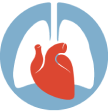This video demonstrates a technique for performing aortic and mitral valve replacements simultaneously through a partial sternotomy with an excellent exposure of the corresponding anatomical structures. The patient was an 86-year-old male patient who presented with a case of severe aortic and mitral valve regurgitation, CHF, and hypertension. A minimally invasive approach was performed through a 6 cm skin incision and an upper partial sternotomy with extension to the third right intercostal space.
The Seldinger technique was utilized to cannulate the ascending aorta and the right femoral vein to establish cardiopulmonary bypass. The aorta was cross-clamped and the heart was arrested with a 2-liter single dose of HTK-Custodiol cardioplegia. The aorta was transected above the sinotubular junction and the remaining cardioplegia was given directly into the coronary artery ostia. A traction suture on the aorta was placed to aid the exposure of the left atrial dome. An incision was made in the dome of the left atrium to expose the mitral valve. The valve was exposed with an Estech retractor. The anterior leaflet of the mitral valve was removed. A series of interrupted 2-0 Ethibond pledgeted sutures were placed into the annulus of the mitral valve. The prosthesis was lowered into place and the sutures were tied with a Cor-Knot. The dome was closed with 4-0 Prolene sutures in a continuous fashion in two layers. Attention was then switched to the aortic valve.
The aortic valve leaflets were removed and a series of interrupted 2-0 Ethibond pledgeted sutures were placed into the annulus of the aortic valve. The sutures were passed through the sewing ring of bioprosthesis. The prosthesis was lowered into place and the sutures were tied with a Cor-Knot device. The aortotomy was closed in two layers with 5-0 Prolene sutures in a continuous fashion. The patient was closed in a standard fashion and had an uneventful hospital course.




As an co-author of the publication I would like to add some references here.
Superior approach to the left atrium was first described by Meyer et al in 1965 [Ann of Thorac Surg, 1965;1(4):453-457].
More recently, several authors published series on minimally invasive mitral valve surgery through the superior approach including cases with concomitant aortic valve procedures [Ngaage DL and Nair UR, Heart Surg Forum. 2002;5 Suppl 4:S421-30; Légaré JF et al, Eur J Cardiothorac Surg. 2003 Mar;23(3):272-6; and Esposito G et al, Innovations (Phila). 2012 Nov-Dec;7(6):417-20].
Thank you for watching!
One more brilliant presentation of a fascinating operation.
Dino keep intriguing and amazing us. Just one question, why did you choose to
place the pledgeted sutures on the ventricular side of the mitral valve and is this your usual technique?
Well done !!!
Thank you very much for your kind comments. I have always put the sutures with the pledgets in the ventricular side. I do not think it makes a difference. Txs again
Dear Dino,
Excellent video.As you Know I use the left atrial dome approach since 2006 as described in a paper (Innovation 2012).
I would like to know how you approach a dilated and very fragile left atrial wall that could be dangerous to close after the procedure on the mitral valve
In these cases I suggest to reinforce the atriotomy with pericardial strip
Do you agree with me?
Dear Giampietro. Thank you very much for your nice comments. I am fully aware about your work with the dome approach to the mitral valve. Congratulatiins for a great series. Also i agree with the reinforcement with the pericardial strips for difficult cases. Best. Dinos
Hi, congratulations for this great presentation.
I think your definition of great exposure is somehow different from my colleagues.
Especially in the case of the mitral valve. My questions are:
– was it desire of the patient, this small incision approach (our older population typically does not ask for it)
– what is the increment in cost
– what is the increment in cross clamp time and “all surgery” time.
– what was the greatest complication you had to deal with, when using this
– what is the % of patients operated this way?
Please provide more videos, as they are very useful.
Many thanks for your help.
Dear Carlis
Txs for your comments
All isolated valves are being done minimally invasively in my institution including roots, valve sparing and arches
The ministernotomy offers great exposure
For root surgery it is better to go to the 4 intercostal space
There is no difference in the cross clamp and bypass times
This procedures are great for all patients particularly for older individuals. Much faster recovery time. Txs
Dinos Plestis